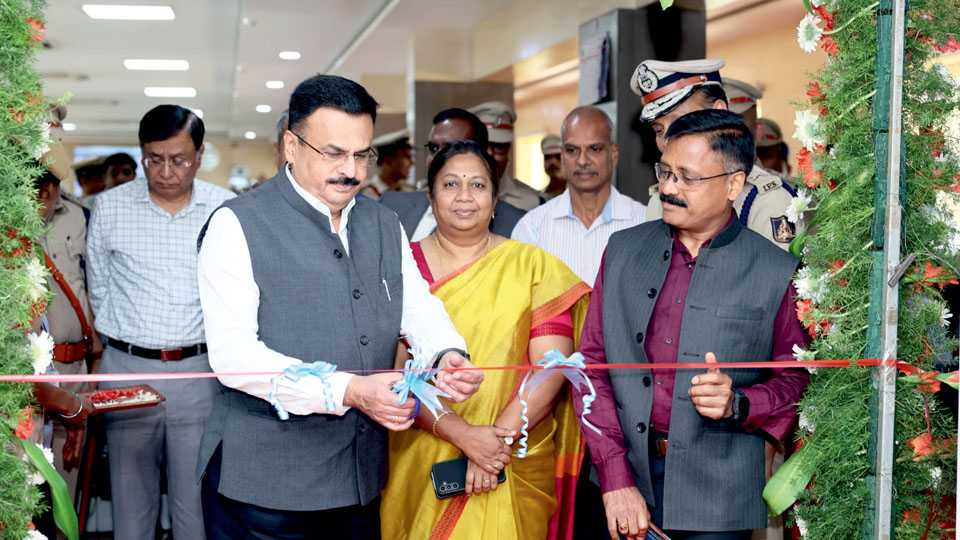- info@example.com

Bengaluru: In response to the growing menace of online financial frauds across the country, the Karnataka Police Department has enhanced its Cybercrime Helpline 1930 by introducing an upgraded web bot system (Voice-Guided WebBOT system) and Interactive Voice Response (IVR) facility, aimed at improving public access to emergency cybercrime support.
This was announced yesterday by Director General and Inspector General of Police (DG&IGP) Alok Mohan during the formal inauguration of the upgraded facility at the ADGP Communication, Logistics & Modernisation (CL&M) office, Corner House, M.G. Road, Bengaluru.
4.34 lakh calls in 2025
He said that Karnataka’s Cybercrime Helpline 1930 has witnessed a massive surge in call volumes — from 1.30 lakh calls in 2022 to 8.26 lakh in 2024. In just the first quarter of 2025 (January to March), the Helpline has already received 4.34 lakh calls.
The DGP noted that the ever-increasing volume of online financial fraud was affecting citizens daily and required quicker reporting mechanisms. The upgraded 1930 Helpline and the newly integrated web bot now enable citizens to register complaints more promptly, especially within the crucial “golden hour” following a cybercrime, which is often key to successfully freezing stolen funds.
Difficulty in reporting cyber fraud
Alok Mohan added that Karnataka’s Emergency Response Support System’s Public Safety Answering Point has been set up within the premises of the ADGP, Communication, Transport and Modernisation office. The 1930 Helpline centre operates in tandem with the National Cyber Crime Reporting Portal (NCRP), where all complaints related to financial fraud are officially registered.
However, the dramatic rise in the number of calls has also resulted in an increased number of call drops. A substantial portion of these calls were related to status updates or general grievances, which inadvertently delayed the registration of fresh complaints. As all Helpline staff were actively handling calls, many citizens attempting to file new complaints, particularly senior citizens, were unable to reach the Helpline in time.
“This delay has made it difficult to report frauds within the golden hour, often resulting in the successful transfer of stolen funds into fraudsters’ accounts before banks could act,” Mohan explained.
To address this critical issue, the Police Department has introduced an IVR system to efficiently categorise calls into four major types: financial fraud complaints, non-financial cybercrime complaints (like WhatsApp/Facebook hacks or impersonation), status-related queries and other grievances. This classification allows the system to prioritise those who are trying to file fresh complaints.
Voice-Guided WebBOT
Further improving accessibility, a Voice-Guided WebBOT system has been integrated into the Helpline process. If a complainant cannot reach a staff member directly or voluntarily disconnects the call due to long wait times, an SMS with a link to the web bot is automatically sent.
The citizen can then submit the complaint details online via the web bot and the Helpline staff later enter the information into the NCRP manually. “This method ensures that new complaints are not missed, even when our lines are busy,” said the DGP, highlighting that the initiative will reduce call drop rates while maintaining efficient complaint registration.
The inauguration event was attended by several senior officials, including ADGP (Law and Order) Hitendra, ADGP (Administration) Soumendu Mukherjee, ADGP (Training) Alok Kumar, ADGP for Karnataka State Fire and Emergency Services Nanjundaswamy, and DGP Malini Krishnamurthy, among others.
New features in 1930 Helpline
As part of the Cybercrime Helpline 1930 upgrade, several advanced features have been introduced to streamline complaint registration and improve response times:
• The existing telephone infrastructure has been upgraded to SIP (Session Initiation Protocol) lines, significantly enhancing the Helpline’s capacity to handle the rising volume of complaint calls.
• A multi-language Interactive Voice Response (IVR) system is now in place, enabling callers to choose their preferred language — Kannada, English or Hindi — for communication.
• When all staff are engaged and lines are busy, the IVR system now informs callers of their position in the queue, reducing confusion and ensuring transparency.
• In the case of non-financial cybercrime complaints — such as WhatsApp or Facebook account hacks and impersonation — an SMS containing a link to self-resolution resources is automatically sent to the complainant.
• A dedicated system has been established to collect, categorise and store data related to both fraud victims and suspected fraudsters. This structured data will support investigators in tracking cybercrime trends and identifying repeat offenders.
• The Cybercrime Helpline 1930 has been upgraded with state-of-the-art software and infrastructure at an estimated cost of Rs. 1 crore. The goal is to offer faster and more effective assistance to victims of financial fraud.
• The Helpline will operate 24×7, reaffirming its commitment to delivering uninterrupted support to citizens affected by cybercrime.
The post Cybercrime Helpline 1930 upgraded with a web bot appeared first on Star of Mysore.